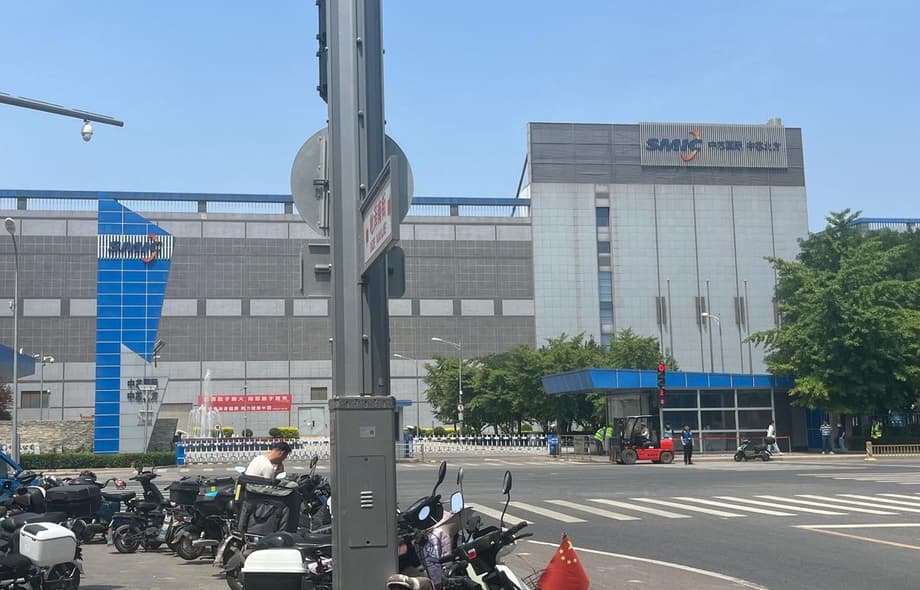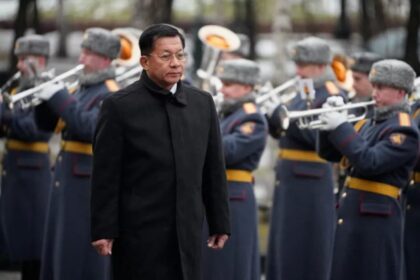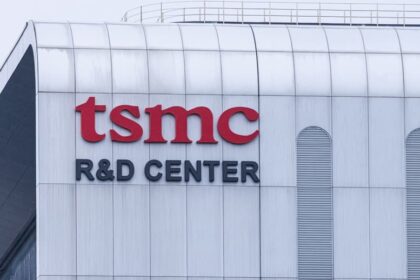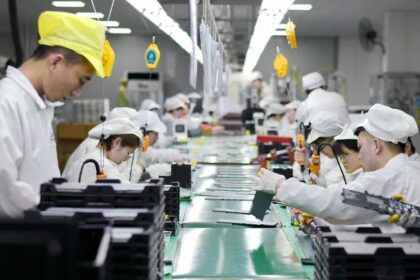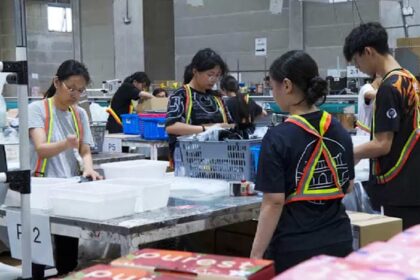Korean exporters brace for a harder fight
A new poll of major Korean manufacturers points to a sharp rise in Chinese competition across the board over the next five years. In a survey by the Federation of Korean Industries (FKI) of 200 firms among the nation’s 1,000 largest by sales, respondents said all ten of Korea’s leading export sectors could be overtaken by Chinese rivals within five years. Today, 62.5 percent of companies view China as their main competitor in global markets, far ahead of the United States at 22.5 percent and Japan at 9.5 percent. Looking ahead to 2030, 68.5 percent expect China to be the top rival, while 22 percent cite the United States and 5 percent Japan.
To gauge the pressure, the survey fixed Korea’s competitiveness at 100 and asked firms to rate others. China is perceived to stand at 102.2 now and to climb to 112.3 by 2030. The United States sits at 107.2 today and is projected at 112.9, which would put it at near parity with China in five years. Across industries, respondents said Chinese firms are already stronger than Korean peers in steel, general machinery, secondary batteries, displays, and automobiles and parts. Korea still holds a narrow lead in semiconductors, electronics and electromechanics, shipbuilding, petrochemicals, and bio health, yet companies expect China to surpass them in each of these areas by 2030.
Corporate leaders also compared the nature of competition. China, they said, is moving ahead on price, productivity, and government support. The United States is stronger in brand power, key personnel, and core technologies. Korean firms cited several obstacles to their own growth: concerns about worsening product quality at 21.9 percent, rising global risks at 20.4 percent, a shrinking domestic market due to a falling population at 19.6 percent, and shortages of skilled workers in areas such as artificial intelligence at 18.5 percent.
The stakes are high for an economy where trade has long powered growth and paid for innovation. The warning from boardrooms is not only about cheaper products. It is also about speed, scale, and a very different style of industrial organization emerging out of China, one that blends large home demand, rapid investment cycles, and heavy use of software and automation in factories.
Which sectors are most at risk
Five sectors have already been eclipsed, according to the companies polled. In steel, global oversupply and China’s lower costs have long pressured Korean mills, while Chinese producers invest in high strength and specialty grades. In general machinery, price gaps and fast delivery schedules have helped Chinese firms win orders in developing markets. Secondary batteries have tilted toward China through leadership in materials, supply chains, and scale, especially with lithium iron phosphate chemistries that cut costs. Displays have seen China’s makers expand capacity in liquid crystal panels and push into premium organic light emitting panels. In automobiles and parts, Chinese brands are exporting more widely, and their electric models are reshaping price expectations in key markets.
In the five sectors where Korea still leads today, executives see that advantage fading. For semiconductors, respondents rated Chinese competitiveness at 99.3 now but 107.1 by 2030. In electronics and electromechanics, China moves from 99.0 to a projected 113.0. In shipbuilding, China goes from 96.7 to 106.7. In petrochemicals and oil products, from 96.5 to 106.2. In bio health, from 89.2 to 100.4. These are not distant timelines for industries that invest on long cycles.
The United States remains a serious competitor in several fields. Korean firms currently see an edge over American peers in steelmaking, shipbuilding, and secondary batteries. By 2030, they expect that U.S. steelmakers will move ahead. The message from boardrooms is that Korea faces a two front race, with Chinese challengers gaining speed in cost and scale, and U.S. firms stressing talent, brand, and upstream research.
Semiconductors remain critical, but the race is changing
Chips are the anchor of Korea’s export profile, and they illustrate a shifting map of rivalry. An industry study by the Korea Trade Investment Promotion Agency (KOTRA) shows China as Korea’s top competitor in semiconductors, with an export similarity index of 72.2 in the third quarter. Other challengers are gaining ground. Taiwan’s index rose by 7.6 points over four years to 32.5, and Malaysia’s by 6 points to 50.5. Malaysia now handles about 13 percent of global assembly, testing, and packaging, which has become a critical step as advanced chips require complex stacking and precision interconnects.
Shifting chip routes
Korea’s chip exports are also moving to new destinations as supply chains adjust. The share going to China and Hong Kong has fallen from 61.6 percent in 2020 to 51.7 percent in 2024. Within that, China’s share fell from 40.2 percent to 33.3 percent, and Hong Kong’s from 20.9 percent to 18.4 percent. Exports to the United States stayed broadly stable at about 7 percent, but shipments linked to the U.S. market are larger when sales to Taiwan are factored in, because high bandwidth memory (HBM) from Korean producers is packaged with graphics processors in Taiwan before final delivery to American customers. Taiwan’s share of Korean chip exports jumped from 6.4 percent in 2020 to 14.5 percent in 2024. Vietnam’s share also increased as production of electronics shifted from China, with Korean component makers following final assembly lines to Southeast Asia.
New rivals in packaging
Backend steps such as assembly, testing, and packaging have become more important as performance gains rely on advanced packaging, not only front end lithography. Malaysia has grown into a major hub in this part of the chain. For Korea, that is both opportunity and warning. Outsourcing can speed scaling and lower costs, yet it also creates a dependence on capacity outside the country. Korean firms and policymakers are looking at how to expand advanced packaging at home, while still tapping partner capacity in Asia to handle surges in demand.
Why Chinese firms are closing the gap
China’s advantage is no longer just cheap labor. It is a mix of scale, efficient logistics, a huge domestic market, and strategic investment in know how. Studies tracking innovation across advanced industries point to rising output from China’s labs and factories. The country has pulled ahead in some markets, like electric vehicles and batteries, and is catching up in others such as robotics and chemicals. The production model is changing as well. Factories use more automation and software, including artificial intelligence systems that manage inventory, process quality checks, and guide robotics. This helps compress cycle times and cut defects, which lower costs and free capital for faster product updates.
Cost pressure from China is reshaping global prices. Battery cells based on lithium iron phosphate chemistry have become cheaper and more reliable. Chinese automakers export models at prices that force rivals to rethink their designs and sourcing. Solar panels are far cheaper than a decade ago. These trends partly stem from scale and process learning, not only subsidies. The result is tougher math for competitors, who must either match costs or differentiate decisively on performance and software.
Brand strength is part of this story. Chinese companies are gradually improving perceived quality in global markets. The FKI survey suggests that by 2030 Korea may no longer hold a clear brand advantage. That would remove one of the final buffers that has helped Korean firms defend prices in premium segments.
How Korean firms are responding on the ground
Korean champions are not standing still. Memory makers are investing heavily in HBM and other premium memory for artificial intelligence workloads. Display leaders are doubling down on premium panels for phones, tablets, and TVs, where image quality and power use matter most. Shipbuilders are winning orders for liquefied gas carriers and complex offshore projects, fields that demand engineering depth and reliable delivery. Chemical firms are pushing into higher value materials that feed batteries, advanced packaging, and electronics. Automakers are focusing on software features, next generation batteries, and reliable global service networks to separate their electric lineups from budget rivals.
Competition with China in export markets does not only threaten margins. It can also stimulate innovation among Korean firms. Research using patent data and firm level measures of export competition shows that when Chinese exporters challenge Korean companies in third country markets, productive Korean firms increase their rate of innovation. The improvements show up in product quality and technology upgrades. The lesson is that pressure in global markets can speed internal change, though it also raises the bar for less productive companies.
Many firms are also diversifying markets and production. Investments in the United States and Europe give better access to customers and can reduce exposure to sudden policy shifts. Battery joint ventures in North America and Europe support local content rules and bring Korean suppliers closer to automakers. Consumer electronics and component lines have expanded in Vietnam and other Southeast Asian economies, so supply chains do not rely on a single country.
Policy choices and cooperation options
Executives flag shortages of skilled workers, quality concerns, and weak domestic demand as constraints. Policy can help on several fronts. Training and immigration policies can expand the pool of engineers and technicians in areas such as AI, chip design, power electronics, and advanced manufacturing. Digital tools can raise productivity in services and in small and mid sized enterprises, where adoption is still limited. Programs should encourage growth and consolidation of competitive firms rather than protecting every small company regardless of performance. Tax and regulatory updates that encourage investment in new equipment and software can speed diffusion of best practices across the economy.
Industrial policy is already shifting. Korea’s Materials, Parts, and Equipment Strategy 2.0 aims to reduce vulnerability to supply disruptions. Continued attention to the full chip stack is essential, from materials and equipment to design, advanced packaging, and back end testing. Support for pilot lines and scale up finance can help promising technologies cross the gap from lab to factory. Clear rules and predictable time lines will matter as much as funding.
Cooperation with partners is another lever. Korea and Germany face similar pressures from rising protectionism and Chinese competition. Sharing approaches to economic security, working together on standards in semiconductors, batteries, and AI, and coordinating supply chain diversification can protect investment while keeping markets open. Middle power cooperation can help avoid heavy handed policies that backfire by choking innovation.
Korea also has more bargaining power in its relationship with China than it once did. Over recent years, Korean firms have reduced exposure to the Chinese market where needed, while Chinese companies still depend on Korean technology in chips, displays, and industrial equipment. The experience of economic retaliation after the THAAD deployment in 2016 pushed firms to diversify. That history helps explain why Korean companies are now more assertive about risk management while keeping trade channels with China open where it makes sense.
Risks to watch in the next five years
Trade policy will remain a moving target. New tariffs and anti subsidy actions in autos, batteries, and clean energy could complicate market access. Korean exporters will need to navigate compliance rules across multiple jurisdictions.
Price pressure is intense. If Chinese firms continue to cut prices while improving quality, margins will be squeezed for many Korean exporters. That will test the ability to differentiate on software, service, and integration with customer systems.
Overcapacity is a risk in several sectors. Steel, batteries, and some commodity chemicals could see volatile cycles if investment outruns demand. Firms will need flexible production plans and disciplined capital spending.
The talent gap could widen without action. Shortages of engineers and technicians in AI, chip design, and advanced manufacturing would slow product cycles. Education, training, and targeted immigration can help, but results will take time.
Geopolitical risk can disrupt supply chains. Tensions among large economies, export controls, and sanctions can alter where and how Korean firms produce. Diversified sourcing and stronger ties with multiple partners can reduce exposure.
What to Know
- Korean boardrooms expect Chinese competitors to overtake all ten of Korea’s leading export sectors within five years.
- China is rated at 102.2 on a 100 based scale versus Korea today, rising to 112.3 by 2030, while the United States is projected at 112.9.
- Chinese firms are already ahead in steel, machinery, secondary batteries, displays, and autos and parts, and are seen moving past Korea in semiconductors, electronics, shipbuilding, petrochemicals, and bio health by 2030.
- Executives say China leads on price, productivity, and state support, while the United States leads on brand, talent, and core technologies.
- KOTRA data shows China as Korea’s top semiconductor competitor, with Taiwan and Malaysia gaining, especially in advanced packaging.
- Korean chip exports are shifting away from China and Hong Kong toward Taiwan and Vietnam, as HBM flows through Taiwan to serve U.S. demand.
- China’s factory model uses scale, software, and automation to cut costs and speed product cycles, intensifying global price pressure.
- Research on Korean firms finds that export competition with China can stimulate innovation among the most productive companies.
- Policy options include expanding the skilled workforce, boosting digital adoption in smaller firms, strengthening the chip and materials ecosystem, and building supply chain resilience with partners.
- Key risks include trade restrictions, price pressure, overcapacity, talent shortages, and geopolitical shocks that could disrupt sourcing and sales.


